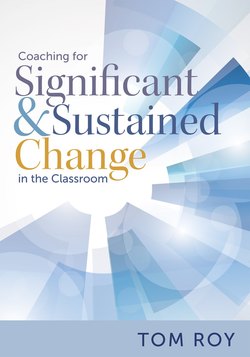Читать книгу Coaching for Significant and Sustained Change in the Classroom - Tom Roy - Страница 9
На сайте Литреса книга снята с продажи.
ОглавлениеIntroduction
Matt Schnur was a master teacher. He was also among the best mentors and coaches. In the late 1960s, Matt coached me through my first years of teaching (though the term coaching as applied to teachers was not yet in use). No one asked him to; no one paid him. He was an experienced biology teacher who had many years of outstanding teaching under his belt. I was a first-year teacher who, because of the rapid growth in school population paired with a lack of certified science teachers, had neither graduated college nor student taught. Matt’s response was neither condescending nor trivial. He offered help from day one. As a result, my professional growth was rapid and impressive. I had the benefit of observing and being coached by a master teacher with significant experiential background.
The coaching took several forms. Matt visited my classroom to observe and provide support. He explained curriculum development and how to modify content and lab experiences to fit the syllabus, then critiqued the results and offered further suggestions. He helped with and reviewed lesson plans. He watched me teach, offered suggestions for improvement, and gave me directions for practicing the skills. He also invited me into his classes to watch him—perhaps the most powerful experience. I could determine from the students’ perspective what content he taught, how discipline unfolded, how to be present to each student, and how to differentiate as understanding (or lack thereof) became apparent. Matt showed me how to write a good assessment and study the students’ performance to determine how to proceed—and then he did it again. Matt encouraged me to review student test data in light of improving learning (in addition to establishing grades). We discussed very specific skills, tried them in the classroom, and practiced them until I was good at them. At the end of the year we sat back and celebrated our success. And then we began year two.
As my career developed, coaching continued to play a central role. In the 1970s, I was an elementary science specialist working with 240 teachers in Weymouth, Massachusetts on how to implement hands-on science lessons. We didn’t call that coaching either, but it was. We had no model, so we built one. From a pretty ugly start to a nicely refined model, my colleague Jack Hackett and I shaped a method to help elementary teachers add skills to their repertoires.
Through years as an administrator and college professor, coaching was always with me. From schools with excellent instruction to those that struggled, from large urban districts to small rural schools, I continued coaching and working with coaches. This book is based on those experiences. It is not about the instructional strategies themselves but the process of teaching others to discover those skills and add them to their teaching. It is about fulfilling that dream of lifelong learning for teachers, coaches, administrators, and, most of all, the students they serve.
As I was getting ready to leave the first school in which I taught, I was getting a little emotional trying to thank Matt Schnur for helping me get better. He just asked me to “pass it on.” I have tried to make that a hallmark of my career—to get better and to pass it on. Coaching can be formal or informal, but helping each other get better truly is a part of lifelong learning for those of us who profess to be educators. It is the very heart of teaching. The worst teacher you have ever seen can get better and so can the National Teacher of the Year. Too often, we as teachers stay within our silos; instead, embrace your skills and share your strengths with a colleague. Getting better is the only thing.
How to Use This Book
This book is a comprehensive resource for coaches and leaders who want to use coaching to improve instruction in their schools or districts. Chapter 1 provides rationale and research on the efficacy of coaching—one of the only ongoing and embedded professional development devices that creates significant and sustained change in teachers’ skillsets. Chapter 2 focuses on the coaching cycle, a course of events that work together to guide teachers through the change process. Chapter 3 describes methods and techniques that coaches employ to communicate with teachers and help them through the process. Considerations for developing or improving a school- or districtwide coaching program are the subject of chapter 4. Peer coaching, both as a program in itself or as a tool for a coach to extend his or her reach, comprises chapter 5. Finally, chapter 6 explores the responsibilities of coaches or administrators who supervise coaching programs. Readers can investigate these chapters sequentially or seek out topics of particular interest. In addition, the appendix presents forms and other practical resources that coaches and leaders can use in their daily work with teachers. On the whole, this book will guide you as you gain the knowledge and implement the practices that constitute coaching for significant and sustained change.
